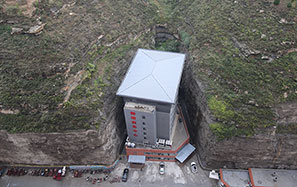Smoggy days arrive early in northeastern regions
Extreme air pollution levels measured in Harbin; haze to linger elsewhere
As coal-burning heat systems came alive in mid-October in Northeast China's Heilongjiang province, the smog that usually waits for late autumn and winter came early.
Meteorological authorities in the province issued an orange alert for heavy air pollution on Wednesday, the second-highest alert in the nation's four-tier emergency response system.
Smog has widely blanketed the province, including Harbin, Suihua, Hegang, Jiamusi, Shuangyashan, Qitaihe, Jixi and Mudanjiang.
The air quality index in Harbin, the capital, for example, hit 500 from late Wednesday to early Thursday, according to the National Environmental Monitoring Center.
Anything above 300 is considered hazardous. The World Health Organization recommends no more than 20.
Smog will also hit other northern regions over the weekend. Pollution is forecast to linger in Beijing and Tianjin, and the provinces of Hebei, Shanxi, Henan and Shandong from Saturday to Tuesday, according to the Ministry of Environmental Protection.
The six provincial regions are required to make adequate preparations for smog and initiate emergency plans for severe bouts.
"Heilongjiang is a major food producing area and the burning of crop stalks left over from the year's harvest contributes to dense air pollution," said Liu Youbin, a senior official in the ministry's publicity department said after a news conference on Tuesday. "The coal burning is another significant source of air pollution in the province."
On Thursday, Li Mu, a teacher at Heilongjiang University who is on business in Acheng district, about 52 kilometers from central Harbin, said: "This morning, I found lots of farmers burning stalks in the fields along the highway. There was a smell of smog pervading the air inside the bus.
"The prohibition of open burning is not the best way, I think, to solve the problem," she said. "The government should continue to figure out new methods to make good use of the stalks and straw."
Unfortunately, there has been little wind to help dissipate the airborne particles, said Fang Lijuan, chief forecaster at the Harbin meteorological station.
"A cold front will bring wind on Thursday, and conditions may change a little for the better. However, the city may see pollution worsen, with the weather growing warmer starting on Saturday," Fang said.
Xiao Chang, 35, an employee at a State-owned enterprise in Harbin, was in a hurry to select and purchase an air purifier on the internet.
"My 3-year-old daughter shows great discomfort in the bad weather and has a serious cough," he said. "Her condition didn't change even though we kept her at home to prevent harm.
"The air purifiers have become a daily necessity for many people around me, and some families have more than one. I hope it can help make her feel better."
According to Zhao Qingdong, a respiratory physician at Harbin First Hospital, "Air pollutants, including PM2.5, PM10 and sulfides, are hazardous, especially for children and the elderly. They can cause illnesses such as bronchitis and asthma."
He added: "In the smoggy weather days, we should reduce outdoor activities and choose light and healthy meals."
Liu, the publicity official, said the ministry has promoted a series of measures to control air pollution in the northeast.
"Three inspection teams have been dispatched to Heilongjiang, Jilin and Liaoning provinces to supervise related government organs," he said.
Environmental experts from the national monitoring center have also arrived to provide technical assistance, he added.
Zheng Jinran contributed to this story.




















